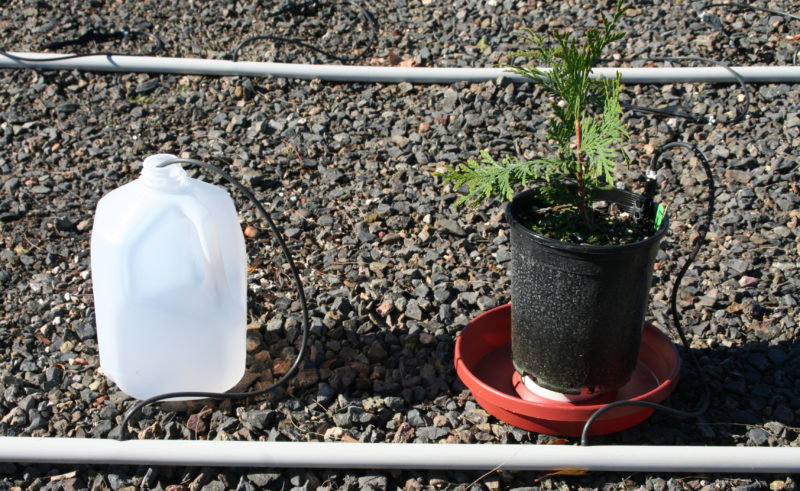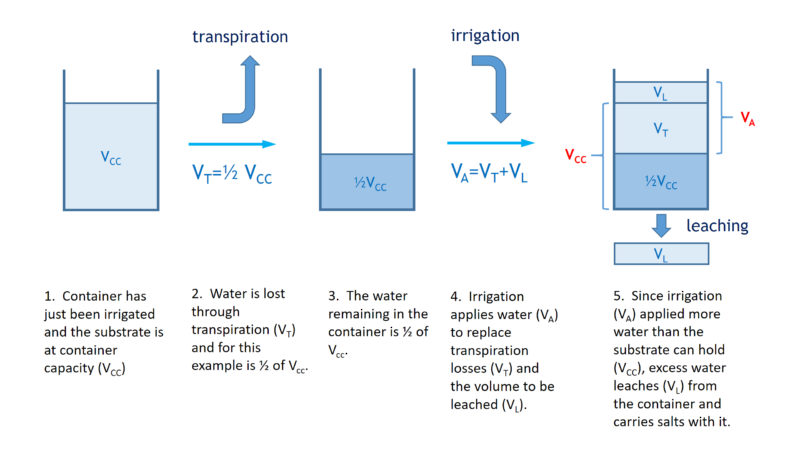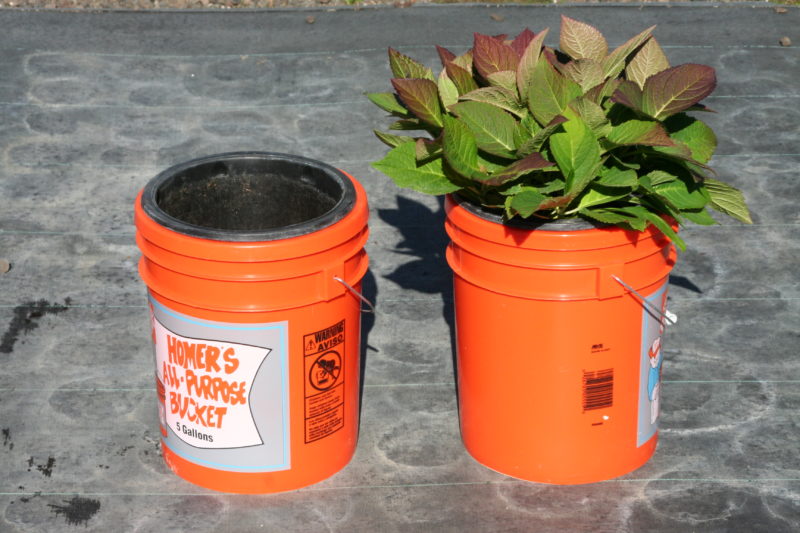
Managing Irrigation by Measuring Leachate
Irrigation management is very difficult since there are numerous factors that influence the irrigator’s decisions. These factors include: the composition of the substrate, container size, plant species and size, plant nutritional requirements, weather, type and condition of the irrigation system, and the quality of the water that is applied.
Soilless substrates (i.e., growing media), by design, are tolerant of over-irrigation. Soilless substrates have high porosity, but little water retention when compared to soils. Furthermore, only half to two-thirds of the water retained in the substrate is available to the plant to use. Since the risk of overwatering is low, growers tend to irrigate frequently with excess water to avoid plant water stress. However, fine tuning your irrigation can lead to numerous benefits that include: conserving water, reducing energy and fertilizer usage, reducing runoff that contains pollutants, and improving plant health and quality.
When fine tuning your irrigation schedule, the amount of water you irrigate needs to, at minimum, replace the water that is used by the plant (transpiration) and evaporated directly from the substrate into the atmosphere (evaporation). The sum of these two water losses is “evapotranspiration.” Water quality must also be considered since water includes salt in additional to the mineral nutrients (i.e., more salts) from your fertilizer.
Plants will use the majority or all the available water in the substrate; however, they will be selective when taking up salts creating a buildup of salts over time. This becomes worse when water quality is poor or if fertilizer is overapplied. An additional amount of water needs to be applied at each irrigation to “push” these salts out of the container (Figure 1). This article provides details of on an-easy-to-use method to measure leaching fraction to better schedule irrigation and avoid the salt build up that can be detrimental to your crop.

WHAT IS LEACHING FRACTION?
The leaching fraction is the ratio of the volume of the leachate to the volume of the applied water. The applied water is equal to that received by a container. The leachate is the amount of applied water that enters the substrate, flows through it, and exits through the container drainage openings. This is typically determined daily, regardless if irrigation is applied once or multiple cycles each a day. The leachate, or drained water, carries away the salts that were in the substrate water in the container.
WHY MEASURE LEACHING FRACTION?
Leaching fraction tells you if you are applying too little, too much or just the right amount water when you irrigate. The method considers the water use of the crop, effect of the crop canopy and substrate properties. If you have or are prone to salt issues, measuring the leaching fraction will also inform you if you are adequately applying enough water to leach salts that are accumulating in the substrate. The buildup of salts may slow crop performance or cause damage to the plants. There are two ways to measure leaching fraction.
HOW TO MEASURE LEACHATE BY VOLUME
With overhead irrigation, to measure the leachate from planted #4 size containers or smaller, you will first need to modify the lid of a 5-gallon bucket (Figure 2). Larger plant containers will require larger capturing containers and lids. Cut an opening in the lid so that either an empty or planted container will nest into the opening on the lid of the container. Make sure there is a snug fit between the opening in the lid and the container to ensure water does not leak into the bucket. Putty, caulk or other material can be used to make sure water does not flow from the lid into the bucket. When the lid and plant are placed on a bucket, only the water draining out the bottom of the plant container should be collected, and the water that does not enter the substrate should be excluded. An empty plastic-lined container of equal size to the planted container or a second bucket with an empty container are placed near the plant container-in-bucket set up.

Irrigate normally when needed, wait about an hour to allow the excess water to drain from the substrate. Use a graduated cylinder or other measuring cup to measure the volumes of the water collected in the buckets. The water from the empty container represents the amount of applied water and the water from the planted container is the leachate amount.
Calculate the leaching fraction by dividing the leachate volume by the applied water volume.
Leaching fraction = leachate volume ÷ applied volume
The volume method can provide leaching fraction values greater than 1.0 or 100% leaching since the canopy of the planted container can collect more water than an empty container. This occurs when plant canopies are greater diameter or taller than the empty, lined container. The weight method described below will always provide a leaching fraction between 0.0 and 1.0.
If using a drip irrigation or spray stakes, a pan under a raised container and milk or juice jug can be used to collect leached and applied water (Figure 3).
MEASURING BY WEIGHT YIELDS ADDITIONAL INFORMATION
A scale can be used to easily convert weight in grams to volume when it comes to water (1 mL = 1 gram). When using the weight method, first separately weigh: 1) the empty bucket and 2) the planted container before the plant needs to be irrigated (Figure 4). Place the modified bucket lid on the bucket and then nest the planted container in the the lid. Make sure that water that lands on the lid will not be able to drain into the bucket. Place the planted container and bucket in the irrigation area.
Complete an irrigation event and then wait about an hour to allow all of the water to drain from the substrate into the bucket. Remove the irrigated plant from the bucket and reweigh it, then weigh the bucket with the collected water. Subtract the pre-irrigation weights from the corresponding post-irrigation weights. What you
will determine:
1. Water retained by the plant = irrigated plant – “dry” plant
2. Leachate volume = bucket with water – empty bucket
3. Applied water volume = water retained by the plant + leachate volume
4. Leaching fraction = leachate volume ÷ Applied water volume
WHAT THIS INFORMATION TELLS YOU
For most levels of salinity of the production system (water, fertilizer, substrate), a leaching fraction of 0.20, an amount equivalent to 20% of applied water draining from the container, is necessary to ensure you are applying adequate amount of water and leaching any excess salts. If the electrical conductance (EC) of your water, including nutrients for liquid feed systems, is greater than 2.0, then a leaching fraction of 0.30 is required to leach the additional salts. If the total salinity is less than 1.0, then a leaching fraction of 0.10 is sufficient. If the water quality is very poor, you may also want to look at treatment or blending higher quality water to lower the salinity. Information regarding this can be found at the CleanWateR3.org website, from literature on the topic, or your cooperative Extension agent or specialist.
When the leaching fraction is greater or less than optimal, you will need to adjust your irrigation duration. The closer you are to the target, the more accurate each adjustment is. An estimate* of the adjustment to the runtime can be calculated by:
TA = t × (LFT – LFM)
Where:
• TA is the time adjustment
• t is the current duration of the irrigation
• LFT is the targeted leaching fraction
• LFM is the measured leaching fraction
• *This is a simplified version of the actual calculation
OTHER BENEFITS
A benefit of using the bucket method for plants irrigated by overhead irrigation is that the leachate represents the amount water that actually enters the container, and it takes into consideration both the water that lands directly on the substrate and the water that is intercepted by the plant canopy. This is important because the architecture of the canopy could either direct the intercepted water into the container (for example, a vase-shaped plant) or the water could be shed away from the substrate surface (an umbrella-shaped canopy with broad leaves, for example). A simple pruning can have a dramatic effect and result in a change in the amount of water applied.
Measuring leachate can be a good tool to determine if the proper amount of water is applied at each irrigation to control substrate salinity. It is quick, inexpensive, easy to do and will provide the information you need to be a better irrigation manager. Using the information gathered can reduce water use, improve nutrient use efficiency and reduce runoff. For more detailed information on this method, download the Virginia Cooperative Extension publication at: www.pubs.ext.vt.edu/content/dam/pubs_ext_vt_edu/spes/spes-128/SPES-128.pdf.


 Video Library
Video Library 




















